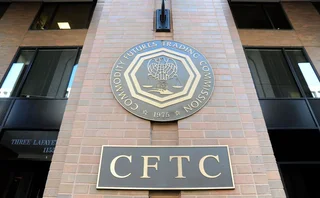Nasdaq CEO Bob Greifeld: Slow and Steady
Bob Greifeld discusses his career, HFT and blockchain with Dan DeFrancesco.
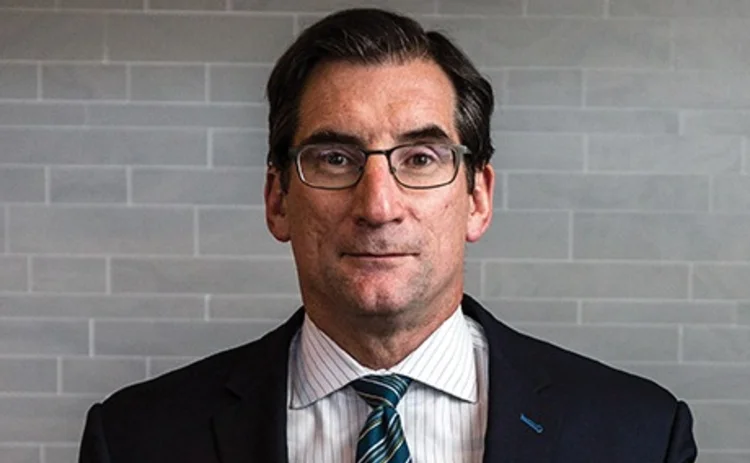
Bob Greifeld fits the traditional profile of a capital markets CEO. He’s well spoken, intelligent and quick-witted. He’s got strong opinions on the market, as one would expect of a person with his experience, and has a habit of tapping his fingers on the table as he talks, as if he needs to physically drill home his point while speaking.
There is, however, one topic that causes Greifeld to break into a smile: his collection of turtles.
He keeps them in the backyard of his home in Western New Jersey for the majority of the year. The tortoises—he has three—come inside during the winter, but the turtles hibernate outside. He brings the babies inside as well, even though he doesn’t have to. He admits that some family members find his hobby unusual, with the exception of his daughter, who is totally on board.
Greifeld says there is no rational reason why he has the turtles. He’s liked them since he was a kid.
It’s ironic for a man whose business deals in microseconds to have a passion for an animal notorious for its slowness, but that’s the beauty of Greifeld. As trading on exchanges—and the technology that underpins it—continues to get faster, Greifeld has never forgotten the attitude that got him to where he is today, which he borrowed from his four-legged friends with shells.
“When you’ve been any place for a while and you’re successful, there is a greater tendency to want to look back as opposed to looking forward. If I’m not focused on blockchain, on Nasdaq Futures, on Nasdaq NLX, on what we’re doing in terms of acquisitions, then I shouldn’t be here," - Bob Greifeld, Nasdaq
“Turtles are dinosaurs. They are survivors. They get there in a workman-like fashion. I certainly believe in life that it never comes easy. You just have to keep plugging away,” Greifeld says. “I remember reading a Bill Gates book in the early days, and he said he’s failed at everything he tried the first time. I believe in the turtle pace. Slow and steady will get you a long way.”
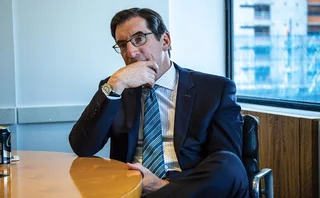
No Easy Start
Greifeld’s workman-like mentality has a basis in his upbringing. As a kid he had to quit his school’s track team, where he ran the 400- and 800-meter races, to work for his father’s landscaping business.
He was born in Queens, N.Y., and raised on Long Island, spending time in Smithtown and Commack before landing at Lake Ronkonkoma, where he spent the majority of his childhood. Every day after school let out at 1 p.m. Greifeld would immediately start mowing lawns. It was, he explains, maturing work.
At Iona College in New Rochelle, N.Y., Greifeld majored in English. It might seem like an unusual choice for someone who now heads up a company in which technology is so deeply embedded, but reading was and still is a passion of his.
Growing up he was a fan of the Beat Generation authors. Greifeld even strongly considered using his degree to teach at Iona Prep, but decided against it because, as he puts it, “reality was intruding and I had to make a living and pay rent and student loans.”
That’s not to say he completely cut ties with his degree. His first job out of college was with computer mainframe company Burroughs Corporation. The grandfather of the Beat Generation, author William Burroughs, established the firm, which is what initially attracted Greifeld to it.
The job proved to be extremely valuable early on, as Burroughs had an excellent training program offered to employees like Greifeld, who had a liberal arts background. The courses focused not so much on specific types of coding, but instead on helping Greifeld understand overall computer architecture. The experience rekindled an interest in computers that was first sparked for Greifeld in high school.
“It’s something I had a passion for and enjoyment for, and I knew I was in the right place,” Greifeld says. “The computer will do what you tell it to do if you say it the right way. I knew I was in the proper place for me, being involved in the computer world.”
Importance of Education
Burroughs’ training program was one of two educational endeavors Greifeld participated in that he considers vital to his overall development. The second came years later when he enrolled in New York University’s MBA program.
Greifeld is proud of the value the MBA provided him, albeit not for traditional reasons. As an English major, he admits that there was always a slight insecurity that he didn’t know anything. The intensive accounting and finance courses gave him a foundation to learn.
The degree itself held no value to Greifeld, since his total compensation at his job at the time was twice as much as most firms were offering MBA graduates. The benefits came in terms of how Greifeld would approach business decisions down the road.
“I have a fun time trying to battle our finance department on different accounting principles. If I didn’t have that foundational knowledge then it would have been hard to learn over the years, and nearly impossible to absorb advanced concepts. Knowing debits are on the left and credits on the right helps,” Greifeld says. “I got tremendous return out of that education without once ever using it as a credential to get a job. Its benefit was indirect and fundamentally more impactful.”
Greifeld eventually made the move to Automated Securities Clearance (ASC) in 1990 with a goal of automating Nasdaq market-makers. SunGard acquired the firm nine years later. His four years at SunGard proved to be pivotal in giving him the necessary experience to move on to Nasdaq.
At ASC, Greifeld admits he was a micromanager. He had deep knowledge of the one vertical ASC was operating in, but not financial services as a whole. The company had only 200 employees by the time it was acquired, and Greifeld preferred not to delegate work. Once at a company the size of SunGard, that type of approach would be impossible. It was while flying out of Stockholm that he realized he needed to change his tactics.
“Best case, I’m going to make it back to Stockholm in six months. I better have someone good in Stockholm running it,” Greifeld remembers thinking. “I learned quickly that I needed to build a management team that could stand on its own. That was a great learning experience for me.”
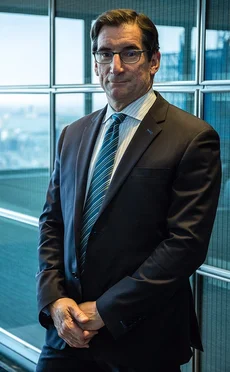
Tough Start
Greifeld landed at Nasdaq in 2003. The early days were rough, to say the least. In fact, Greifeld almost missed his first day of work. On a whim, he decided to run a marathon in Ottawa, despite not training for it, the day before he started his new job. The weather was bad, and the plane had to be de-iced, despite it being May. The airport had put the de-icing machine in storage, thinking the worst of the winter weather had already passed. Eventually, the necessary tools were found, but not before the airport nearly ran out of supplies.
The conditions in New York weren’t any better.
“I would go home at night saying, ‘I think I’m six months too late,’ for the first year,” Greifeld says. “I’d like to have had a magic wand. … We had obsolete mainframe technology, which was reliable and well-engineered, but was not able to respond to the dynamic aspects of the new competitive forces.”
Greifeld was fighting a losing battle against competing trading venues that were able to put out new releases to meet customer demands within a week. Meanwhile, his firm was still on a yearly release cycle. Nasdaq was losing market share every day, according to Greifeld, and the firm was in organizational peril.
It wasn’t until the acquisition and integration of electronic trading platform Inet was completed in 2005 that Greifeld says things started turning around. From there it was a series of technology acquisitions and internal developments that led Nasdaq to where it sits today.
“You plant the bud and it grows a little bit and then it can flower quite dramatically over the fullness of time,” Greifeld says. “So when you look at where we are today and where we are tomorrow it seems like apples and oranges, but if you deconstruct it along the way, we’ve made logical steps.”
The Future
As far as those future endeavors go, two of the hottest technologies in the space—blockchain and artificial intelligence—are squarely in Nasdaq’s crosshairs. For the former, Greifeld says his firm has a core belief that blockchain will change everything over time, but the current focus is on delivering solutions over the next 12 months. The firm was able to do that at the end of 2015 when it executed a transaction via blockchain for Nasdaq Private Market.
As far as industry-wide adoption of blockchain is concerned, that will take a bit longer, but its impact will be felt, Greifeld says.
“I think the clearing infrastructure we know today will be entirely different,” Greifeld says. “It will be eviscerated within a decade.”
During Nasdaq’s Investor Day presentation in March this year, Greifeld included a clip from the “The Matrix” as an introduction to the firm’s technology plans and the concept of artificial intelligence and machine learning. In the clip, Trinity, played by Carrie-Anne Moss, quickly learns how to fly a helicopter by having all the knowledge needed downloaded into her brain. While at the time the idea might have seemed far-fetched, it’s a potential reality now, Greifeld says.
“My theory on computing technology is this: When I started, the mainframe was in the glass room. It then went to the telco room on the floor. Then it went to your desktop. Then it went to your laptop. Then your phone. Now it’s on your watch,” Greifeld says. “It’s coming closer and closer to your body. It’s coming into your body. Compute power is coming in. So it’s been a long-term trend. It keeps getting closer.”
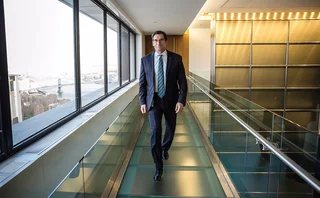
High Frequency
It wouldn’t be a meaningful conversation with the CEO of Nasdaq without bringing up high-frequency trading (HFT), and Greifeld is willing to broach the topic. He is quick to clarify that he never said IEX was bad for the markets. The trading venue, chronicled in Michael Lewis’ Flash Boys, is currently waiting for approval from the US Securities and Exchange Commission (SEC) for its application to register as a national securities exchange.
IEX’s application has been a hot topic in the industry, particularly regarding its “speed bump” feature, developed to slow down high-frequency traders and provide what it believes will be a fairer market.
Greifeld says Nasdaq approached the SEC before IEX with a similar plan. He and Eric Noll—now CEO at brokerage Convergex, but who at the time was the executive vice president of transaction services at Nasdaq—came up with the idea of taking one of the firm’s three equity licenses and creating a delay that would make it equal to the slowest of the exchanges.
When Nasdaq pitched the idea to the SEC, Greifeld says the regulator promptly turned it down, claiming that it was technically not in the spirit of the markets because an exchange is not allowed to slow down its systems.
Nasdaq dropped the idea and went back to the drawing board because, as Greifeld points out, it didn’t have a book supporting its endeavor. IEX’s concept is even more aggressive than Nasdaq’s original idea, yet it’s being seriously considered, Greifeld says.
“We’re not philosophically opposed to a speed bump. But it can’t be a one-off. It should be a policy decision by the SEC and the exchange,” Greifeld says. “What the Commission has to recognize is the complexity of the market is going to explode. Because what they are essentially doing is putting a time dimension to an order. Today, if you send an order in and you want to buy 1,000 shares of Apple at a price, I get three dimensions to it: buy, shares and price. Now I’m going to say, I want to buy 1,000 shares of Apple at a price with a one-microsecond delay, and then I’ll put another order type in with a two-microsecond delay and another with three. I’ll count every microsecond off.”
The deadline for the SEC’s decision is June 18. Regardless of the regulator’s decision, there will continue to be more compliance and technology hurdles that Greifeld will have to navigate his ever-evolving firm through.
Whether he’ll still be the one leading Nasdaq in the years to come remains to be seen. His contract with the firm ends in 2017, but that’s about all the information you’ll get out of him. When asked about the legacy he hopes to leave behind, he scoffs at the idea. Like a true workman, his focus is only on the task at hand.
“If I think about legacy, I should be fired. Every day is a new day and we can fail in spectacular ways on any given day,” Greifeld says. “When you’ve been any place for a while and you’re successful, there is a greater tendency to want to look back as opposed to looking forward. If I’m not focused on blockchain, on Nasdaq Futures, on Nasdaq NLX, on what we’re doing in terms of acquisitions, then I shouldn’t be here.”
Bob Greifeld Fundamental Data
Name: Bob Greifeld
Age: 58
Birthplace: Queens, New York
Title: CEO of Nasdaq
Education: BA in English from Iona College, MBA from New York University
Personal Hobbies: Skiing, running, cycling, golf and shooting clays
Only users who have a paid subscription or are part of a corporate subscription are able to print or copy content.
To access these options, along with all other subscription benefits, please contact info@waterstechnology.com or view our subscription options here: http://subscriptions.waterstechnology.com/subscribe
You are currently unable to print this content. Please contact info@waterstechnology.com to find out more.
You are currently unable to copy this content. Please contact info@waterstechnology.com to find out more.
Copyright Infopro Digital Limited. All rights reserved.
As outlined in our terms and conditions, https://www.infopro-digital.com/terms-and-conditions/subscriptions/ (point 2.4), printing is limited to a single copy.
If you would like to purchase additional rights please email info@waterstechnology.com
Copyright Infopro Digital Limited. All rights reserved.
You may share this content using our article tools. As outlined in our terms and conditions, https://www.infopro-digital.com/terms-and-conditions/subscriptions/ (clause 2.4), an Authorised User may only make one copy of the materials for their own personal use. You must also comply with the restrictions in clause 2.5.
If you would like to purchase additional rights please email info@waterstechnology.com
More on Regulation
Regulators can’t dodge DOGE, but can they still get by?
The Waters Wrap: With Trump and DOGE nipping at regulators’ heels, what might become of the CAT, the FDTA, or vendor-operated SEFs?
CFTC takes red pen to swaps rules, but don’t call it a rollback
Lawyers and ex-regs say agency is fine-tuning and clarifying regulations, not eliminating them.
The European T+1 effect on Asia
T+1 is coming in Europe, and Asian firms should assess impacts and begin preparations now, says the DTCC’s Val Wotton.
FCA sets up shop in US, asset managers collab, M&A heats up, and more
The Waters Cooler: Nasdaq and Bruce ATS partner for overnight market data, Osttra gets sold to KKR, and the SEC takes on DOGE in this week’s news roundup.
Waters Wavelength Ep. 312: Jibber-jabber
Tony, Reb, and Nyela talk about tariffs (not really), journalism (sorta), and pop culture (mostly).
Experts say HKEX’s plan for T+1 in 2025 is ‘sensible’
The exchange will continue providing core post-trade processing through CCASS but will engage with market participants on the service’s future as HKEX rolls out new OCP features.
No, no, no, and no: Overnight trading fails in SIP votes
The CTA and UTP operating committees voted yesterday on proposals from US exchanges to expand their trading hours and could not reach unanimous consensus.
Big xyt exploring bid to provide EU equities CT
So far, only one group, a consortium of the major European exchanges, has formally kept its hat in the ring to provide Europe’s consolidated tape for equities.


